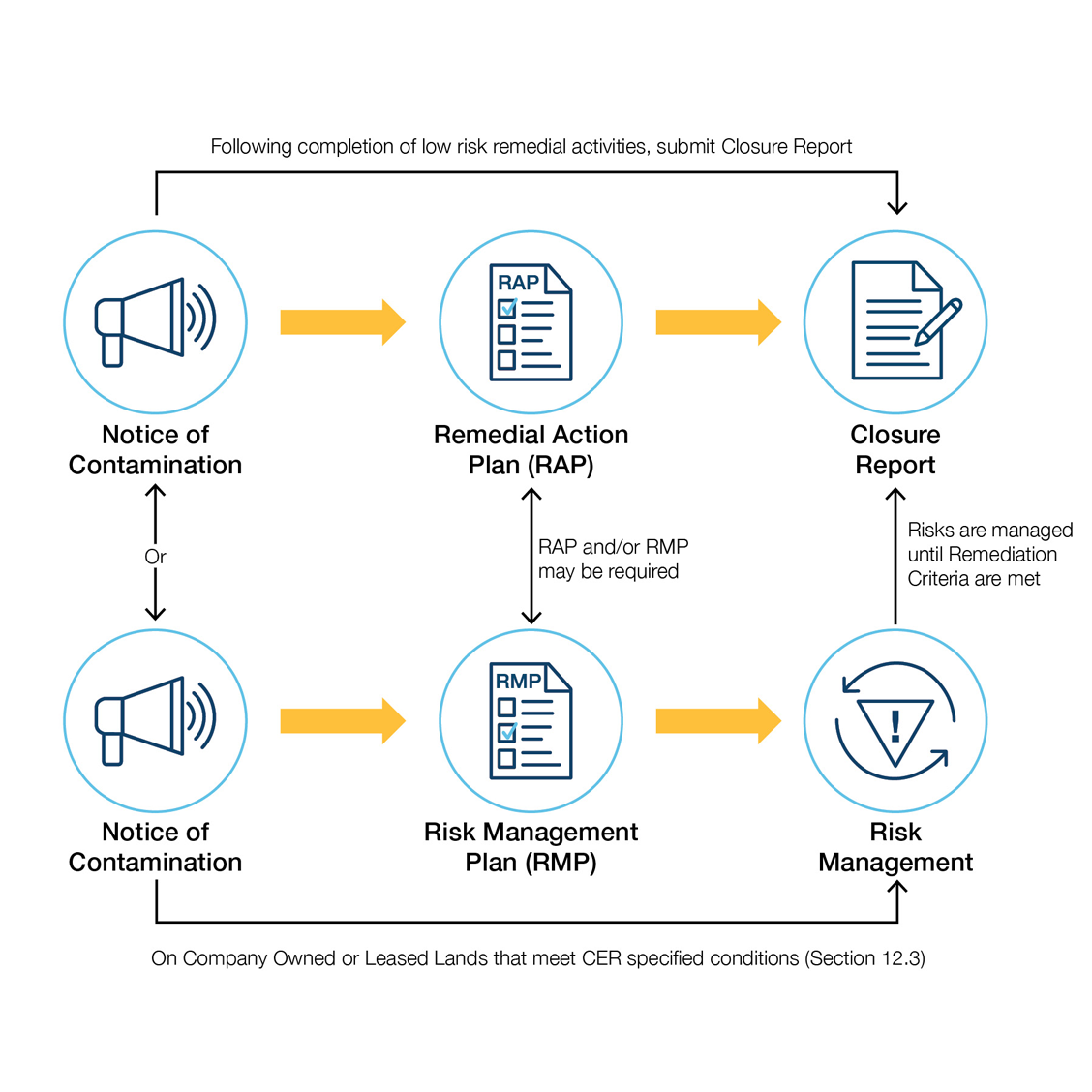1. CER’s Approach to Transparency
Openness, transparency, and accountability are guiding principles of the Government of Canada. The CER gives Canadians access to information concerning Facilities and their potential impacts on the environment and the health and safety of the public. We are focusing on increased public access and awareness about how our activities protect the public and the environment throughout the entire lifecycle of a Facility. These activities include the process we use to regulate the management of Contamination.
We are committed to meaningful engagement with Indigenous Peoples, landowners, and all stakeholders so we can make informed decisions in the public interest. Engaging with Canadians requires relevant information be routinely available and accessible to the public.
2. Purpose
We are committed to protecting the environment from Adverse Effects of Contamination related to CER-regulated Facilities. We have developed the CER 2020 Remediation Process Guide to explain to companies how to demonstrate successful Remediation upon identification of Contamination, or in the event of a hydrocarbon or other type of Release. This Guide describes the most common approaches a company can use to demonstrate the Contamination associated with CER-regulated Facilities has been appropriately remediated to the most stringent of provincial or federal generic Remediation Criteria or to the established Site-Specific Remediation Objectives.
This Guide does not address every condition that may need to be considered during the Remediation process. For inquiries related to specific contaminated sites, contact remediation@cer-rec.gc.ca.
2.1 Application of Guide
This Guide applies to Facilities that are regulated by the CER under the Canadian Energy Regulator Act (CER Act), the Canada Oil and Gas Operations Act (COGOA) and the Oil and Gas Operations Act (OGOA) and all applicable regulations.
The Guide does not apply to initial clean-up of free product from a Release. This activity must be managed under emergency response activities as specified in the company’s Emergency Procedures Manual, required under the Onshore Pipeline Regulations (OPR) section 32(1.1).
Regulatory Oversight
The CER’s Regulatory Oversight spans the lifecycle of the pipeline from construction to abandonment. This Guide applies to contamination identified during all phases of the Facility lifecycle, including the period during which pipelines are abandoned.
3. Regulatory Approach
The CER is the lifecycle regulator for federally regulated energy projects. We oversee the environmental protection activities conducted by companies for Facilities under our jurisdiction. Environmental protection activities include the management of Contamination by companies operating Facilities or managing lands under our jurisdiction. In situations where Remediation started prior to 2011, and companies remain engaged with municipal or provincial authorities to obtain site closure, we will continue to act as a stakeholder in cooperation with municipal, provincial or territorial authorities.
For sites with Contamination that are reported to the CER via a Notice of Contamination, we require companies to submit annual updates, as per section 13 of this Guide. Site closure documentation, such as a remediation certificate issued by a provincial authority or other regulator, must be submitted to the CER once the activities to address the Contamination on the site are considered closed by the respective authority or regulator.
We verify for compliance related to identification and mitigation of sites with Contamination, and may use our enforcement tools (potentially in concert with provincial authorities) depending on the site and the circumstances of the matter.
4. Requirements of a Management System
We expect that companies systematically construct, operate, maintain and abandon their Facilities in a manner that protects the environment, including human health and safety. In this section, we describe the requirements that apply through a company’s management system under which individual contaminated sites are reported and managed at a program level, as part of a required environmental protection program.
4.1 The Environmental Protection Program
The OPR section 48, states:
"A company shall develop, implement and maintain an environmental protection program that anticipates, prevents, manages and mitigates conditions that could adversely affect the environment."
4.2 The Management System
Management system requirements, as provided in the Onshore Pipeline Regulations (OPR) under the Canadian Energy Regulator Act (CER Act) and the Drilling and Production Regulations (DPR) under the Canada Oil and Gas Operations Act (COGOA) provide the framework for the management of Contamination through companies’ environmental protection plans and programs. The management system must be established, implemented and maintained throughout the entire lifecycle of the Facility from construction through to abandonment. The management system must be applied to all programs referenced at section 55 of the OPR (i.e., the emergency management program, integrity management program, safety management program, damage prevention program, and security program) and the company’s environmental protection program.
Companies must also be able to demonstrate that the human resources allocated to establishing, implementing and maintaining the management system are sufficient to meet the requirements of the management system and to meet the company’s obligations under section 6 (section 6.4(c) of the OPR).
The framework described below outlines the standard elements of a management system-based environmental protection program a company must implement in order to appropriately address Contamination (based on section 6 of the OPR). The elements include, but are not limited to the content in Framework Elements.
Framework Elements
This framework for management system-based environmental protection programs and related plans to address Contamination is intended to apply to all Facilities the CER regulates. The requirements listed below are taken from the Onshore Pipeline Regulations (OPR).
5. CER Remediation Process
Companies are expected to follow the Remediation Process as illustrated in Appendix A.1. A simplified process is shown in Figure 1.

As conditions and conceptual site models are unique to the site with Contamination, Figure 1 reflects the general framework rather than the approved workflow for individual sites. A low risk remedial activity is determined by the responses to the screening assessment questions that are submitted in the Notice of Contamination in the Online Event Reporting System, the responses to the worksheet in Appendix C, and the professional judgement of the CER environmental analyst.
Sections 6 to 14 describe the steps in our Remediation Process.
- Date modified:
